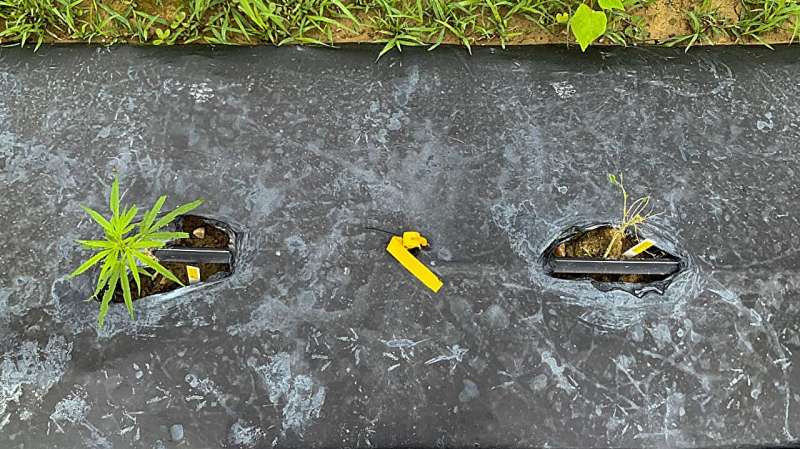This article has been reviewed according to Science X's editorial process and policies. Editors have highlighted the following attributes while ensuring the content's credibility:
fact-checked
peer-reviewed publication
trusted source
proofread
Hemp cannabinoids may have evolved to deter insect pests

Cannabinoids, naturally occurring compounds found in hemp plants, may have evolved to deter pests from chewing on them, according to experiments that showed higher cannabinoid concentrations in hemp leaves led to proportionately less damage from insect larvae.
The study opens the door for potentially developing pesticides from cannabinoid extracts, though such uses would be limited to non-edible plants, given the pharmacological properties of the compounds, which include CBDA, THCA, and their precursor CBGA. These compounds are naturally produced by hemp plants and convert to more commonly known CBD, THC, and CBG when heated.
In the decades since scientists first identified cannabinoids, research has focused on their medicinal and intoxicating effects, but it's never been clear why these plants evolved cannabinoids in the first place. Researchers have hypothesized that cannabinoids may protect plants from ultraviolet light, pathogens, and herbivores.
"It has been speculated that they are defensive compounds because they primarily accumulate in female flowers to protect seeds, which is a fairly common concept in plants," said Larry Smart, a plant breeder and professor in the School of Integrative Plant Science at Cornell AgriTech in the College of Agriculture and Life Sciences (CALS).
"But no one has put together a comprehensive set of experimental results to show a direct relationship between the accumulation of these cannabinoids and their harmful effects on insects," said Smart, who is the senior author of the study, "Cannabinoids Function in Defense Against Chewing Herbivores in Cannabis Sativa L.," which is published in the journal Horticulture Research.
"The study gives us insight into how cannabinoids function in natural systems and can help us develop new THC-compliant hemp cultivars that maintain these natural built-in defenses against herbivores," said George Stack, Ph.D., a postdoctoral researcher in Smart's lab and the paper's first author.
The Cornell hemp breeding program started in 2017 by evaluating different commercially available hemp cultivars to see which ones were best suited for local climate, soils, and environment, so recommendations could be made to farmers. Smart, Stack, and colleagues noticed that varieties originating from a breeding program in Ukraine were all highly susceptible to Japanese beetles, while other varieties were spared such predation.
"At the end of the season, as we characterized the chemistry of those plants, we learned that the plants from the Ukrainian program did not make any cannabinoids," Smart said.
Since varieties that produced more cannabinoids experienced less predation, the team suspected that the compounds may be acting as a defensive agent to protect hemp plants from insect damage, and they devised experiments to test their hypothesis.
In tests using hemp plants with varying concentrations of cannabinoids, the researchers discovered that damage from leaf-chewing insects (cabbage looper larvae) was higher in leaves with lower levels of cannabinoids.
"In the absence of cannabinoids, we saw heavy insect damage, and in the presence of cannabinoids, we saw much less damage," Smart said.
In controlled feeding studies in the lab, the researchers isolated CBDA and CBGA, and painted the extracts on to an artificial insect diet in a range of concentrations. Larvae grew less and had lower rates of survival as cannabinoid concentration increased, according to the paper.
The Cornell program cannot work with high THCA (the intoxicating compound found in marijuana) plants due to federal restrictions, so THCA as a pesticide was not tested in this research, Smart said.
"The potential use of cannabinoids as a pesticide is an exciting area for future research, but there will certainly be regulatory barriers due to pharmacological activity of the compounds, and more studies are needed to understand what pests cannabinoids will be effective against," Stack said.
Future work will investigate if sap-sucking insects, such as aphids, are also inhibited by cannabinoids. The researchers are also exploring whether species from other plant genera that make cannabinoids, such as the South African woolly umbrella plant (Helichrysum umbraculigerum), could also benefit from their insecticidal properties. If so, it would point to an example of convergent evolution, where the same adaptation independently arose in different species at different times and locations.
More information: George M Stack et al, Cannabinoids function in defense against chewing herbivores in Cannabis sativa L., Horticulture Research (2023). DOI: 10.1093/hr/uhad207
Journal information: Horticulture Research
Provided by Cornell University


















